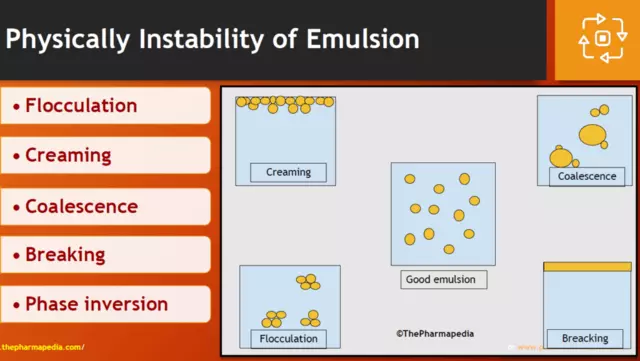
1.Flocculation:
- Neighboring globals come closer to each other ⇒ forms Flocs
- Re-Dispersed on shaking
- Prevented by imparting charges on globules and using uniform-sized globules

2.Creaming:

- Occurs Due to the density difference
- Upward creaming-O/W emulsion
- Downward creaming-W/O emulsion
- If Creaming occurs, Drug is not uniformly distributed ⇒ variable in dosage ⇒ emulsion should be shaken for only before use
3. Coalescence:
- Globules tend to fuse with each other and forms bigger globules and ultimately lead to the breaking of the emulsion
- Occurs due to destruction of emulsifier film around the globules due to insufficient agent or by temperature change or By the presence of micro-organism, or by creaming

4. Breaking:

- Complete separation of aqueous and oil phases
- Irreversible step
5. Phase inversion:
- Change of emulsion type from O/W to W/O and vice versa
Important Points
Vanishing cream: O/W type emulsion.
Cold Cream: W/O type emulsion
Parenteral Preparation: Lecithin (Non-ionic) emulsifying agents
Wedge Thory:
Monovalent soap (Sodium stearate)- O/W type emulsion
Divalent Soap (Calcium stearate)- W/O type emulsion
Also Read…
Introduction to Emulsion
Type of Emulsion
Identification of Emulsion
Formulation of Emulsion
Join Our WhatsApp Group to receive the latest updates like Pharma Job notifications, study materials, admission alerts, Pharma News, etc
Join Our Telegram Group to receive the latest updates like Pharma Job notifications, study materials, admission alerts, Pharma News, etc
Join Our Telegram Group to Download Free Books & Notes, Previous papers for D.Pharm, B.Pharm, M.Pharm, Drug Inspector & GPAT……….

Comments are closed